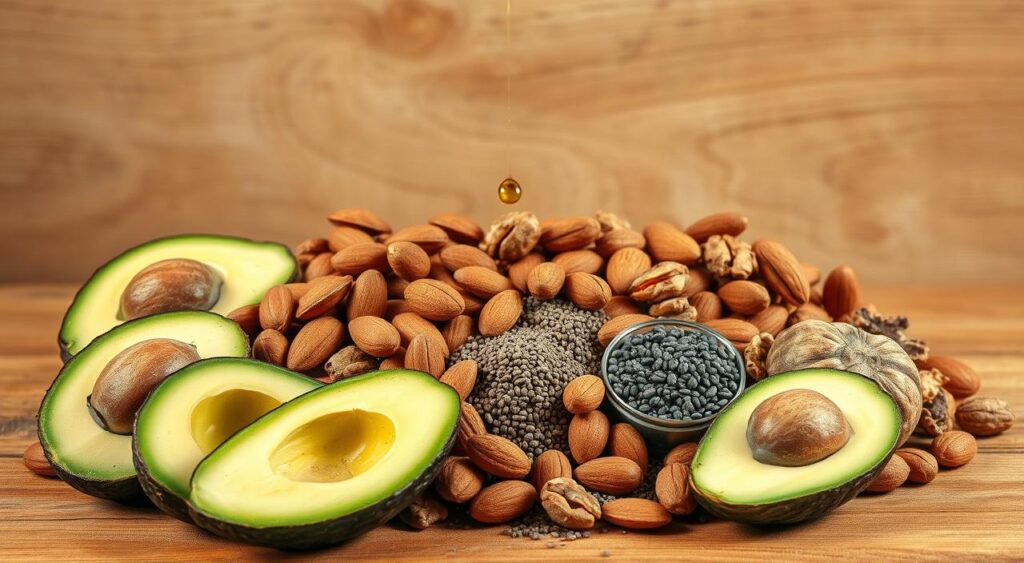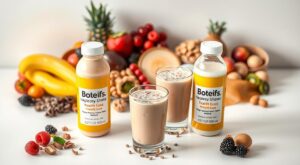Ever thought about how your daily meals affect your heart health? Your diet choices can significantly impact your cholesterol levels. Every meal matters, and a heart-healthy diet can transform your life. This guide will show you how to choose foods that naturally lower cholesterol.
You’ll discover a diet that’s not only delicious but also good for your heart. It’s all about making the right choices to support your overall health.
Understanding Cholesterol
Cholesterol is a waxy, fat-like substance that is vital for our bodies. It helps make hormones and keeps cell membranes strong. Your liver makes cholesterol, which moves through your blood in two main types: LDL and HDL. Knowing about these types is important for your heart health nutrition.
LDL, or “bad” cholesterol, can build up in arteries and cause problems. This buildup can lead to heart issues. HDL, or “good” cholesterol, helps by taking excess cholesterol back to the liver. This promotes heart health.
| Type of Cholesterol | Function | Impact on Heart Health |
|---|---|---|
| LDL (Low-Density Lipoprotein) | Transports cholesterol to cells | Can lead to plaque buildup and heart risk |
| HDL (High-Density Lipoprotein) | Removes cholesterol from the bloodstream | Helps reduce heart disease risk |
Knowing how cholesterol works helps you make better choices for your heart health nutrition. By lowering LDL and increasing HDL, you can work towards a healthier heart.
Why a Heart Healthy Diet Matters
A heart-conscious diet is key to keeping your heart healthy. Eating right can lower your risk of heart disease. It helps manage cholesterol and supports weight control, both important for heart health.
Choosing a heart-protective diet brings positive changes to your life. It includes lots of fruits, veggies, whole grains, healthy fats, and lean proteins. These foods are the foundation for a long, healthy life.
By eating heart-healthy foods, you can live longer and stay fit. You can enjoy tasty meals that are good for your heart. Switching to a heart-protective diet is a great choice for you and your family.
| Key Benefits | Description |
|---|---|
| Cholesterol Management | A heart-healthy diet helps regulate cholesterol levels. |
| Weight Control | Consuming nutrient-dense foods aids in maintaining a healthy weight. |
| Reduced Disease Risk | Lower chances of developing heart-related conditions. |
| Improved Quality of Life | Healthy eating patterns enhance overall well-being. |
Identifying Heart-Friendly Foods
To make a heart-healthy diet, focus on a variety of heart-friendly foods. These foods give you important nutrients and help your heart work well. Lean proteins like chicken, turkey, and fish are great choices. Omega-3 fatty acids in fish like salmon and mackerel are also good for your heart.
Whole grains are key in your diet. Brown rice, quinoa, and whole-grain bread help your cholesterol levels. Fruits and vegetables are also vital for heart health. Choose colorful ones like berries, leafy greens, and citrus fruits.
Don’t forget about healthy fats when picking heart-friendly foods. Add unsaturated fats from avocados, nuts, and olive oil to your meals. These fats lower bad cholesterol and make you feel full. Try to avoid saturated and trans fats found in processed foods.
Choose whole foods over processed ones. Whole foods keep more nutrients and avoid added sugars. Try to cook with little salt and drink less alcohol. For more tips, check out these recommendations.
The Role of Fats in Your Diet
Fats are key to your diet and heart health. They help with many body functions. But, not all fats are good for you. It’s important to eat healthy fats and avoid unhealthy ones.
Healthy Fats vs. Unhealthy Fats
Healthy fats are found in foods like avocados, nuts, seeds, and fatty fish. They help control cholesterol levels by lowering bad LDL cholesterol. On the other hand, unhealthy fats in fried foods and processed snacks can harm your heart.
It’s vital to cut down on trans fats and saturated fats. This helps keep your heart healthy.
How to Choose Heart-Healthy Oils
Choosing the right cooking oils is important for heart health. Oils like olive, canola, and safflower are great. They are full of unsaturated fats that taste good and help your heart.
Choose oils that are processed less. This way, you get more nutritional benefits.

Building Your Heart Healthy Diet
Creating a heart-healthy diet means making smart food choices. You need to focus on lean proteins and whole grains. These foods are key to keeping your heart in top shape. Let’s look at how to add them to your meals every day.
Incorporating Lean Proteins
For a healthy heart, eat lean proteins like skinless chicken, fish, beans, and legumes. These foods are low in bad fats and high in good stuff. They help you stay at a healthy weight and keep your muscles strong.
Choosing Whole Grains
Whole grains are great for your heart. They include foods like brown rice, quinoa, and whole wheat bread. These grains have lots of fiber, which is good for your heart. Switching to whole grains improves digestion and gives you energy all day.
Fruits and Vegetables: Key Players
Adding a variety of colorful fruits and vegetables to your meals is key for a heart-healthy diet. These foods are full of vitamins, minerals, and antioxidants that help your heart. A colorful plate not only looks good but also means you’re getting a wide range of nutrients.
Benefits of a Colorful Plate
Choosing a vibrant mix of fruits and vegetables offers many health benefits, including:
- Rich in Antioxidants: They fight free radicals that can cause heart disease.
- Support Blood Pressure: Many are high in potassium, which helps control blood pressure.
- Boost Fiber Intake: Fiber is good for digestion and can lower cholesterol, making it great for heart health.
- Enhance Weight Management: They are low in calories but full of nutrients, helping you stay at a healthy weight.
How to Incorporate More Fruits and Vegetables
Making fruits and vegetables a part of your daily life is easy. Here are some tips for your heart-healthy eating plan:
- Add fresh or frozen berries to your morning oatmeal or yogurt.
- Put leafy greens like spinach or kale in salads or smoothies.
- Snack on vegetables like carrots, celery, or bell peppers with hummus or guacamole.
- Try roasting or grilling vegetables to make them taste better.

Soluble Fiber: The Cholesterol Fighter
Adding soluble fiber to your meals can boost your heart health. It works by binding with cholesterol, stopping it from being absorbed. This action helps lower your cholesterol levels, which is key for a healthy heart.
Find soluble fiber in oatmeal, beans, lentils, and fruits like apples and oranges. Aim for 10 to 25 grams daily to improve your heart health. Start with oatmeal for breakfast or add beans to your salads. Every bit helps in controlling cholesterol and keeping your heart healthy.
Examples of Heart-Healthy Meals
Adding heart-healthy meals to your daily routine can be both tasty and good for you. Here are some great ideas for breakfast, lunch, and dinner. These meals support heart health without losing flavor.
Breakfast Ideas
Begin your day with breakfasts that boost heart health:
- Oatmeal topped with fresh fruits like berries or bananas
- Smoothies made with spinach, avocado, and a mix of berries
- Whole grain toast with smashed avocado and poached eggs
Lunch Options
For lunch, aim for meals that are balanced and nutritious:
- Salads featuring dark leafy greens, quinoa, and chickpeas
- Whole grain wraps filled with lean turkey, hummus, and assorted vegetables
- Grain bowls with brown rice, black beans, and chopped veggies
Dinner Suggestions
End your day with dinners that are both filling and heart-healthy:
- Baked salmon served with a side of steamed broccoli and quinoa
- Stir-fried tofu combined with brown rice and a colorful assortment of veggies
- Lentil soup accompanied by whole grain bread for a comforting meal
Snack Wisely to Support Heart Health
Snacking can be key to keeping your heart healthy if you pick the right snacks. Adding heart-healthy snacks to your day keeps you full and gives you energy. It also helps you avoid eating too much. Choosing whole, nutrient-rich foods is a big step forward.
Here are some suggestions for heart-healthy snacks:
- Fresh fruit, like apples, berries, or bananas, offers essential vitamins and antioxidants.
- Plain yogurt provides probiotics and calcium, which are beneficial for your heart.
- Veggie sticks paired with hummus deliver fiber and healthy fats.
- A handful of nuts, such as almonds or walnuts, offers protein and omega-3 fatty acids.
Snacking wisely nourishes your body and controls your hunger. These snacks support your health and encourage you to make smart choices all day.
By adding these snacks to your diet, you take control of your heart health. Healthy snacking habits can make you happier and healthier.
Tips for Following a Heart-Healthy Eating Plan
Starting a heart healthy diet can seem daunting. But, making it your own can make it fun and lasting. Begin by finding resources that let you create your own meal plan. Look for options that match your taste and cultural background for a better experience.
Choosing foods you love is key to staying on track. It keeps you motivated and excited about your diet.
Customizing Your Meal Plan
Your diet should fit your life and tastes. Use meal planners that let you mix recipes for variety. Adding seasonal fruits and veggies makes meals interesting and nutritious.
This approach keeps your diet enjoyable and prevents feeling trapped.
Cooking Methods that Preserve Nutrition
How you cook affects your food’s nutritional value. Choose methods like grilling, steaming, and baking over frying. These methods cut down on bad fats and boost flavors.
By using heart healthy cooking methods, you improve your nutrition and heart health.

Shopping for Heart-Healthy Ingredients
When looking for heart-healthy ingredients, a smart shopping plan is key. Fill your cart with whole foods and fresh produce. These are packed with nutrients and low in bad fats, which is good for your heart.
Make sure to include lean proteins like chicken, fish, and legumes in your list. Avoid processed foods that can harm your heart. Whole grains like brown rice and quinoa add fiber, helping your heart and more.
Reading nutrition labels is important for making smart choices. Look at serving sizes and saturated fats. By following these tips, you can pick foods that support your heart health.
Use seasonal produce and sales to save money and eat fresh. Planning your shopping around these deals can make your diet healthier and cheaper.
A Week of Heart Supportive Recipes
Starting a meal plan with heart-friendly recipes can change your eating habits. It can also boost your heart health. Here’s a meal plan for a week, focusing on foods good for your heart.
| Day | Breakfast | Lunch | Dinner |
|---|---|---|---|
| Monday | Oatmeal topped with fresh berries | Quinoa salad with chickpeas and spinach | Baked salmon with steamed broccoli |
| Tuesday | Smoothie made with spinach, banana, and almond milk | Turkey wrap with avocado and mixed greens | Lentil stew served with whole-grain bread |
| Wednesday | Greek yogurt with a sprinkle of chia seeds | Grilled chicken salad with walnuts and vinaigrette | Zucchini noodles with marinara sauce and vegetables |
| Thursday | Whole grain toast with almond butter | Vegetable stir-fry with brown rice | Stuffed bell peppers with quinoa and black beans |
| Friday | Chia seed pudding with sliced bananas | Salmon salad served on a bed of arugula | Grilled shrimp tacos with cabbage slaw |
| Saturday | Pancakes made from whole wheat flour and blueberries | Hummus and vegetable platter with whole-grain pita | Roasted chicken thighs with carrots and sweet potatoes |
| Sunday | Frittata with spinach, mushrooms, and feta | Cauliflower soup with a side of whole-grain bread | Eggplant curry with brown rice |

This meal plan offers a variety of heart-healthy recipes. Each day includes meals full of whole grains, lean proteins, and fruits and vegetables. You can adjust these recipes to suit your taste. Start your journey to better heart health with tasty, nutritious meals.
Monitoring Your Progress
Tracking your diet progress is key to managing cholesterol. Keeping a log of your meals and exercise can show how diet changes affect your cholesterol. Use a step counter to track your daily activity.
Talking to your doctor regularly is important. Blood tests during visits can show how your diet changes are working. Keep a detailed record of your findings to make diet and exercise adjustments. A food diary can help you see what works for you.
Using charts to record your activities can make your results clearer. Knowing your BMI can help you set better weight goals. For more help, check out guides on controlling your heart health.
Conclusion
Starting a heart healthy diet is key to better health. Choosing foods rich in nutrients helps lower cholesterol and boosts heart health. Begin by cutting down on saturated fats and eating more fiber.
Eating a variety of healthy foods makes meals fun and supports heart health. Making small changes to your diet can lead to big health gains. Learn more about diet and cholesterol myths here.
This guide helps you manage your heart health with good eating habits. Remember, a healthy diet is a long-term investment in your future and your family’s.














